Travel: Surprising Discoveries in the Land of a Thousand Hills
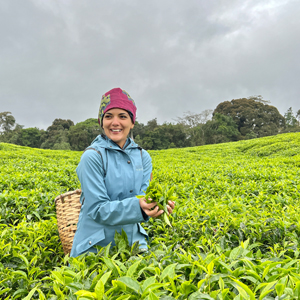
While the Gorilla experience was my main draw for traveling to Rwanda, I discovered so much more: warm hospitality, a reformed national narrative, verdant natural beauty, and an immense diversity of flora and fauna.
[Left] Rwanda is blessed with verdant greens and unparalleled natural beauty everywhere. (Photo: Sucheta Rawal)
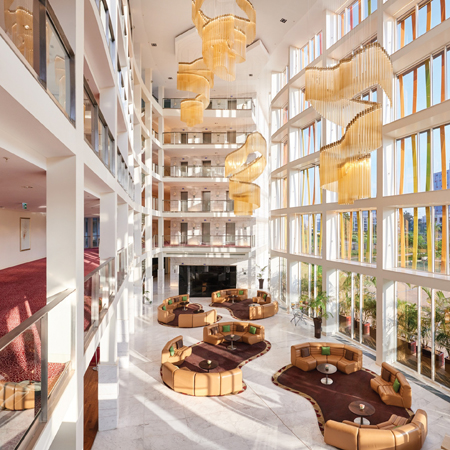
I’m embarrassed to admit that even as a well-seasoned traveler, I did not know much about the country of Rwanda until recently. About the same size as the U.S. state of Maryland, this tiny landlocked nation in the Great Rift Valley of Central Africa has made headlines for the gruesome genocide that occurred 29 years ago, killing and displacing almost a million people.
Interest from world leaders and celebrities in recent years has led to a boom in Rwanda’s economy and infrastructure, as well as a change in its image. According to many recent reports, Rwanda is ranked in the top two safest countries in Africa and the sixth safest country in the world for solo travelers. During my 10 days traveling around Rwanda, I experienced utmost courtesy, warm hospitality, and unparalleled natural beauty, along with one of the most amazing wildlife experiences of my life.
The ultra-modern and luxurious Radisson Blu Hotel and Convention Center in Kigali, the capital city.
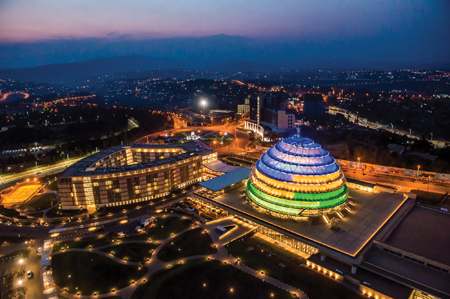
When I landed in Kigali, the capital, I was not expecting to see a luxurious Radisson Blu Hotel and Convention Center surrounded by pristine gardens. After a long flight, I didn’t want to venture out, so I went downstairs to the restaurant at the hotel and was delighted to see samosas and a thali of chicken curry and rice on the menu. It didn’t have the traditional spicy Indian flavor; it was more of an Indo-African style milder version, but it still hit the spot for this “desi at heart.”
There is nothing more comforting than an Indian meal in a foreign land. I came across many people of Indian origin who were working and living in Rwanda. They all claimed they loved the country because of the moderate year-round weather, cleanliness, and civility. Delightfully, over the next few days as I made my way to the corners of Rwanda, I continued to enjoy scrumptious spreads of daal, chapati, sambusas, fish curry, rolex (a type of chapati), brochettes (kebabs), and akabanga (hot chili oil). The buffets of vegetarian, Indian, African, and continental cuisines were much like those offered at five-star hotels across India.
It is worth spending a day exploring Kigali’s urban life. There is a prominent Muslim quarter known as Nyamirambo where you can hear chanting from the mosque and find streets filled with casual eateries specializing in whole, fried tilapia and halal foods.
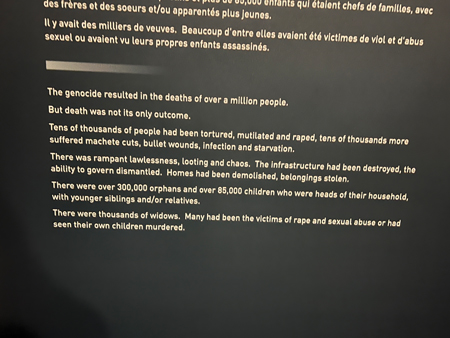
The Kigali Genocide Memorial is a must-visit, a grim reminder of the country’s past but also a symbol of an inspiring outlook for its future. Rwandans today no longer discriminate based on castes or tribes. They are only allowed to be referred to as “Rwandans.” It is apparent in the county’s political and everyday life how President Paul Kagame has influenced the country to follow a model for advancement, self-reliance, and high moral standards.
The Kigali Genocide Memorial is a must-visit. A grim reminder of the country’s past but also a symbol of an inspiring outlook for its future. (Photo: Sucheta Rawal)
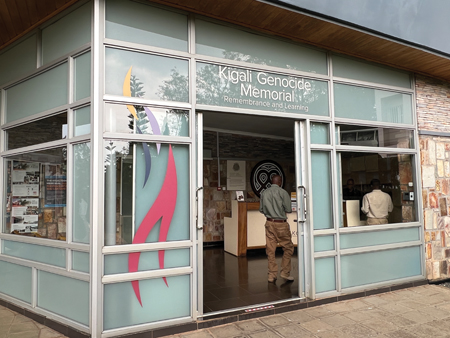
Gorillas: The main draw for travelers to Rwanda
Hordes of tourists from around the world descend upon Rwanda in September for Kwita Izina, the annual gorilla-naming ceremony in the Volcanoes National Park located in the Virunga Mountains in the north of the country. This is the largest event in the country where over 50,000 people gather at what is known as Africa’s first National Park to celebrate the naming of baby gorillas who have been born in the past year. In its 18th annual ceremony, celebrities, sportsmen, actors, and humanitarians congregated at the Park to name the baby gorillas. King Charles of Wales also joined virtually.
It was cold and cloudy at Volcanoes National Park that morning. But the excitement of people from diverse backgrounds raised the crowd’s spirit in unison. Locals had walked from neighboring villages wearing rubber flip-flops while VIP guests arrived in chauffeur-driven Land Rovers. Well-known African performers—young pop artists, dancers, and more—entertained the crowds on an open-air stage with the backdrop of a 15-meter-tall straw sculpture of a gorilla. Enthusiastic little kids, energetic teen scouts, and shy elders—all cheered on, jumping up for joy, proudly waving their blue, yellow, and green-striped Rwandan flags.
In the presence of the country’s leaders and visitors like me, 20 baby gorillas were given meaningful names that symbolized Rwanda’s core values such as service, unity, love, and peace.
It felt more like a national patriotic event than a gorilla-naming ceremony.
Of course, my main reason to travel to Rwanda was also to see the gorillas. Rwanda is one of the only three countries in the world where you can see silverback mountain gorillas in the wild. The high elevations, volcanic soil, thick and lush forests, and cooler temperatures make it ideal for mountain gorillas to thrive. Because of the sustainability efforts of the Rwanda Development Board, the mountain gorilla populations have more than doubled since 2010. With over 1000 gorillas now flourishing in the region, they are no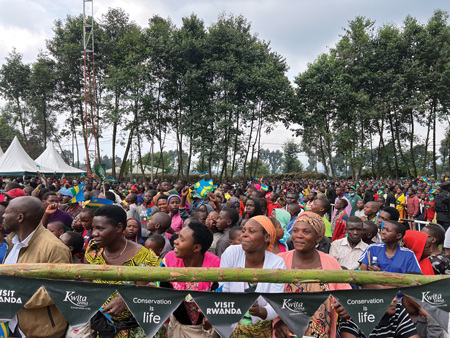 longer considered to be critically endangered. But it is not that easy to see the gorillas in the wild as they live deep in the forest canopies. Unlike other African safaris, a gorilla trek requires serious hiking and a steep price to pay. The entry fee for the Park is 1500 U.S. dollars per person and is limited to 80 persons per day. And when you do encounter these giants in the wild, you are only allowed to spend one hour with them.
longer considered to be critically endangered. But it is not that easy to see the gorillas in the wild as they live deep in the forest canopies. Unlike other African safaris, a gorilla trek requires serious hiking and a steep price to pay. The entry fee for the Park is 1500 U.S. dollars per person and is limited to 80 persons per day. And when you do encounter these giants in the wild, you are only allowed to spend one hour with them.
Over 50,000 people gathered
in the Volcanoes National Park
in the Virunga Mountains in
the north of the country for the
annual gorilla-naming ceremony called Kwita Izina.
(Photo: Paul Kagame, flickr.com)
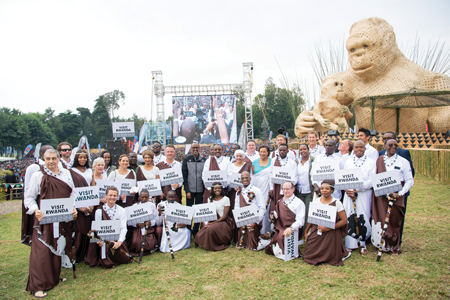
The spirited hospitality industry behind the safari adventures
Not long ago, Volcanoes National Park, located on the borders of Rwanda, Uganda, and the Democratic Republic of Congo, was grounds for civil war and animal poaching. In 2022, the Government of Rwanda announced that it will expand the Park from 50 to 89 square miles over the next five years and create a buffer zone that will minimize wildlife and human conflict by 80 percent.
Rwanda is leading African nations in its sustainability efforts, committed to preserving the habitats of wildlife while creating meaningful employment opportunities for locals. The entire country has benefited from tourism. Enterprising Rwandans have opened tour companies, hotels, coffee shops, art studios as well as community and cultural centers.
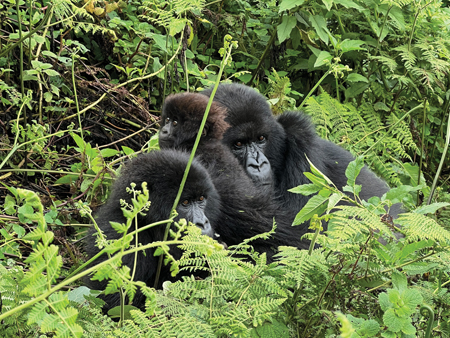
Because of the sustainability efforts of the Rwanda Development Board, the mountain gorilla populations have more than doubled since 2010 and are no longer considered to be critically endangered. (Photo: Sucheta Rawal)
In Musanze, the town which is the main gateway to Volcanoes National Park, I woke up at the crack of dawn to join dozens of other adventure enthusiasts who had come to Rwanda for the same mission. As the peak of Mount Karisimbi (at 4,507 meters) emerged from the Virunga volcanoes in the morning light, cultural performers welcomed us with the sounds of drums and traditional dances. We were offered complimentary tea and coffee sourced from nearby farms. The guides ran around bringing gaiters to cover our legs and ensured everybody had the right footwear, rain jackets, and plenty of water for the day’s trek.
I spent the next two hours riding in the back of a safari Jeep, driving over bumpy dirt roads through villages and farms in the lush green, damp mountains. Our guide was constantly on the radio with the ranger, trying to locate the exact position of the gorilla family that we had set out to see.
Once we got to a point where the vehicle could not go any further, we got out and started trekking through steep slopes, potato farms, and, eventually, thick forests with bamboo, ferns, and stinging nettles. I hired two porters to help me along the way. They held my hand on the slippery paths, carried my backpack, and shared their stories along the journey. Many of these guides and rangers were reformed poachers who now worked to protect the gorillas and their habitats.
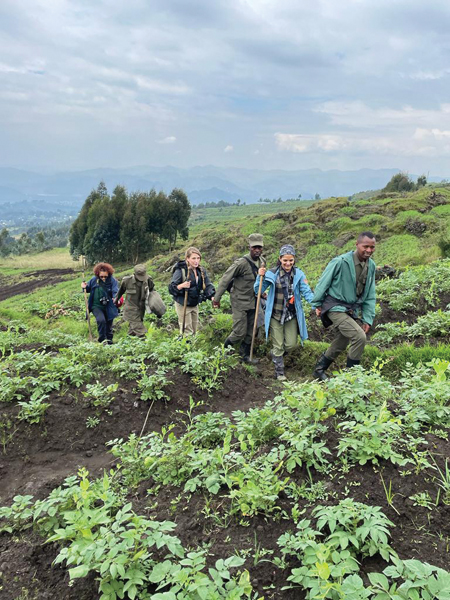
As we got closer to one of the rarely-sighted Susa gorilla families, we had to leave our bags with the porters and walk quietly with just our cameras. The next thing I saw felt straight out of the Discovery Channel! There were giant black beasts only 10 meters away from me—totally oblivious of my presence, just minding their own business. A male silverback alpha rolled around on a pile of leaves, settling for his mid-day nap. Another looked up at me, we made eye contact, then he rubbed his eyes and yawned. A teen scratched his head and put his arm around his mother. A female picked up her baby (one that had been named at the ceremony) with both her arms, give it a big kiss, and propped her down again.
[Left] Unlike other African safaris, a gorilla trek requires serious hiking and a steep payment. (Photo: Sucheta Rawal)
Gorillas are our primate cousins who share 98 percent of the same DNA, which explains why their behavior is so much like that of humans. My porter told me that the gorillas are friendly with humans. They often come down to the fields to pacify crying babies, wrap their arms around people, and play harmless games.
I must have taken over 1000 photographs during that one hour which seemed to fly by. As I look back at those photos months later, it still feels surreal that I was actually there.
While in the area, stay in Musanze for a day or two to visit the newlyopened Ellen DeGeneres Campus of the Dian Fossey Gorilla Fund, a state of the art research center and museum. I also spent an evening at the nonprofit Red Rocks in Musanze where I learned to make banana beer from scratch and danced with the village women.
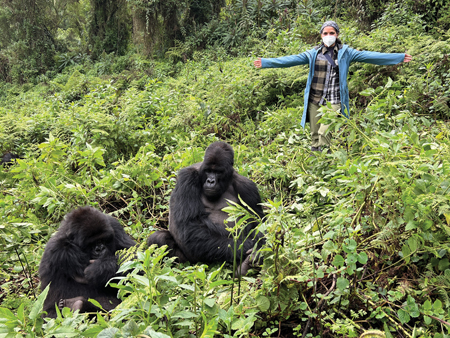
Rwanda is one of the only three countries in the world where you can see silverback mountain gorillas in the wild. But it is not that easy to see them as they live deep in the forest canopies. (Photo: Sucheta Rawal)
An immense diversity of flora and fauna
While gorillas are the main draw for travelers coming to Rwanda, there are many other reasons to extend the trip. The immense diversity of flora and fauna around the country is home to 13 types of primates, 300 bird species, wild orchids, waterberry trees, fire ants, and endangered golden monkeys. I went on a game drive to look for the big five at Akagera National Park in eastern Rwanda on the border of Tanzania. We saw hundreds of zebras, giraffes, buffalos, elephants, gazelles, rhinos, and lots of birdlife around Lake Ihema.
In the southeastern part of the country, near the border of Barundi, you can see many species of chimpanzees as well as owl-faced and colobus monkeys. While some of my friends went on a grueling chimpanzee trek into Nyungwe National Park, I opted for a thrilling walk on the Canopy Walkway, the highest suspension bridge in the country.
Nearby, I took tours of Rwanda’s famous tea and coffee plantations, and even tried my hand at plucking tea leaves. Coffee was introduced to Rwanda by missionaries just over a century ago, and today, there are around 450,000 small growers across the country. You can find Rwandan arabica coffee at specialty coffee shops all over the world.
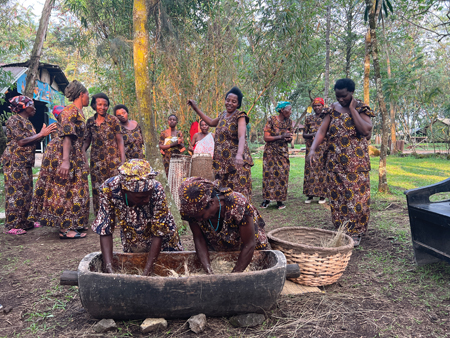
My last stops were along the pristine resort towns surrounding Lake Kivu. At 56 miles long and up to 31 miles wide, it is referred to as one of the African Great Lakes. Surrounded by magnificent mountains covered in pines and eucalyptus trees, the relaxed lakefront towns reminded me of the hill station resorts I frequented as a child in India. Here you can go boating, kayaking, swimming, or simply relax with a good book.
[Left] Banana beer-making demo at Red Rocks community center.
(Photo: Sucheta Rawal)
As I sat on my balcony of the modern boutique Cleo Lake Kivu Hotel, overlooking the sun setting over the deep emerald-colored still waters, I thought about the many different ways that Rwanda pleasantly surprised me. From its breathtaking natural beauty and responsibility towards conserving it, to the indomitable spirit of the Rwandan people and their cheerful attitude, this Land of a Thousand Hills will capture your heart unlike any other destination.
Sucheta Rawal is an award-winning food and travel writer who has traveled to over 100 countries across seven continents, experiencing the world through her palate. She has been named one of the most influential cultural bloggers in the world for her blog Go Eat Give. Find her on social @SuchetaRawal.
Enjoyed reading Khabar magazine? Subscribe to Khabar and get a full digital copy of this Indian-American community magazine.
blog comments powered by Disqus










